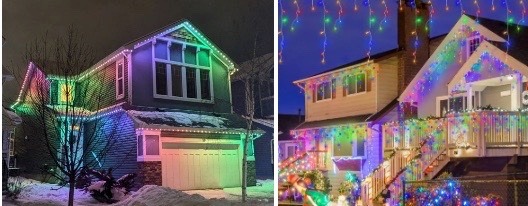Are LED Lights More Energy Efficient than Traditional Christmas Light Bulbs?
LED Lights cost more up front, but are they really worth it in the long run? Short Answer is YES! They are way more energy efficient. Keep reading to understand why.
5/8/20242 min read


You may have noticed many of your neighbours with twinkling white or colourful lights installed into their trim and wondered "how much are they spending on their electricity bill?"
Well the answer is: not that much. In fact, the cost for them to enjoy beautiful lights all year round, is potentially the same or even less than what you may be spending on your electrical bill for the few months of the year you turn on your traditional Christmas light bulbs.
Sure, you might be thinking, "but it only costs $60 for a string of Christmas Lights", vs the $1000-$4000 of having professionals install permanent holiday lights, BUT if you plan to live in your home for more than a couple years, it's worth the upfront cost for the long term energy savings.
Let's delve into the comparison:
Traditional Incandescent Christmas Light Bulbs
Traditional incandescent Christmas light bulbs have been adorning trees and homes for decades. These bulbs work by passing an electric current through a thin filament, heating it until it emits light. While they provide a warm and nostalgic glow, they are not particularly energy efficient. In fact, a significant portion of the energy they consume is wasted as heat rather than light. This inefficiency results in higher energy bills and increased environmental impact.
LED (Light-Emitting Diode) Christmas Lights
LED Christmas lights represent a significant advancement in lighting technology. Instead of relying on a filament, LED lights produce light by passing an electric current through a semiconductor material. This process is far more efficient, as it converts a greater percentage of energy into light rather than heat. As a result, LED lights consume significantly less energy than their incandescent counterparts while producing the same, if not brighter, illumination.
Energy Efficiency Comparison
When comparing the energy efficiency of LED lights to traditional incandescent bulbs, the difference is striking. LED lights typically consume up to 90% less energy than incandescent bulbs to produce the same amount of light. This translates to significant cost savings on energy bills, especially considering the extended duration over which holiday lights are often displayed.
Moreover, LED lights have a much longer lifespan compared to incandescent bulbs. While traditional bulbs may last for only a season or two before burning out, LED lights can last for tens of thousands of hours. This longevity not only reduces the frequency of replacements but also decreases the environmental impact associated with manufacturing and disposing of light bulbs.
Conclusion
In the debate between LED lights and traditional incandescent bulbs for Christmas decorations, the evidence overwhelmingly favours LEDs in terms of energy efficiency. Not only do LED lights consume substantially less energy and have a longer lifespan, but they also offer brighter and more vibrant illumination, enhancing the festive ambiance of any holiday display.
While the initial cost of LED Christmas lights may be slightly higher than that of traditional bulbs, the long-term savings in energy bills and replacement costs more than justify the investment. Additionally, opting for LED lights contributes to environmental sustainability by reducing energy consumption and waste.
With the advantages of more energy efficient outdoor lighting, why reserve lighting up our homes to only the Christmas season? Enjoy a beautifully lit home, choosing from countless colour combinations to enjoy every day, and celebrate every event and holiday!
Consider choosing LED lights to brighten our homes while also shining a light on energy efficiency and conservation. By making this simple switch, we can enjoy more sustainable and cost-effective holiday celebrations for years to come.
sales@getdiamondbright.com
403-618-9173
Follow us on Facebook!
